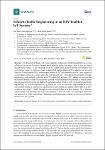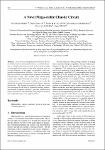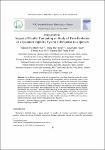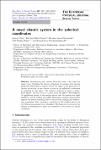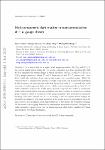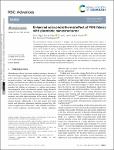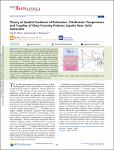Search
Author
- Quan-Hoang Vuong (19)
- Vuong QH (12)
- Nguyen Van Hieu (10)
- Viet-Thanh Pham (10)
- next >
Subject
- Vietnam (4)
- Affective computing (3)
- Artificial Intelligence (3)
- Electrospinning (3)
- next >
Date issued
- 2020 - 2022 (132)
- 2010 - 2019 (19)
- 2002 - 2009 (1)
Search Results
We reconsider the question of electric charge quantization, which leads to the existence of a dark charge nontrivially unified with weak isospin in a novel gauge symmetry, SU(3)C ⊗SU(2)L⊗U(1)Y ⊗U(1)N , where Y and N determine the electric and dark charges, respectively. The new model provides neutrino masses and dark matter appropriately, a direct consequence of the dark dynamics. We diagonalize the fermion, scalar, and gauge sectors as well as obtain relevant interactions, taking into account the kinetic mixing of U(1)Y,N gauge bosons. The new physics signals at colliders are examined. The dark matter observables are discussed. |
The Internet of Things (IoT) is increasingly creating new market possibilities in several industries’ sectors such as smart homes, smart manufacturing, and smart cities, to link the digital and physical worlds. A key challenge in an IoT system is to ensure network performance and cost-efficiency when a plethora of data is generated and proliferated. The adoption of Network Function Virtualization (NFV) technologies within an IoT environment enables a new approach of providing services in a more agile and cost-efficient way. We address the problem of traffic engineering with multiple paths for an NFV enabled IoT system (vIoT), taking into account the fluctuation of traffic volume in various time periods. We first formulate the problem as a mixed linear integer programming model for f... |
In recent years designing new multistable chaotic oscillators has been of noticeable interest. A multistable system is a double-edged sword which can have many benefits in some applications while in some other situations they can be even dangerous. In this paper, we introduce a new multistable two-dimensional oscillator. The forced version of this new oscillator can exhibit chaotic solutions which makes it much more exciting. Also, another scarce feature of this system is the complex basins of attraction for the infinite coexisting attractors. Some initial conditions can escape the whirlpools of nearby attractors and settle down in faraway destinations. The dynamical properties of this new system are investigated by the help of equilibria analysis, bifurcation diagram, Lyapunov expo... |
In an arbitrary system subjected to a quench or an external field that varies the system parameters, the degrees of freedom increase double in comparison to that of an isolated system. In this study, we consider the quantum impurity system subjected to a quench, and measure the corresponding time-evolution of the spectral function, which is originated from the time-resolved photoemission spectroscopy. Due to the large number of degrees of freedom, the expression of the time-dependent spectral function is twice much more complicated than that of the time-independent spectral function, and therefore the calculation is extremely time-consuming. In this paper, we estimate the scale of time consumption of such calculation in comparison to that of time-independent calculation, and present... |
Investigating new chaotic flows has been a hot topic for many years. Studying the chaotic attractors of systems with various properties illuminates a lamp to reveal the vague of the generation of chaotic attractors. A new chaotic system in the spherical coordinates is proposed in this paper. The system’s solution is inside a predefined sphere, and its attractor cannot cross the sphere. Investigation of equilibrium points of the system shows that the system has eight equilibria, and all of them are saddle. Bifurcation analysis of the system depicts the period-doubling route to chaos with changing the bifurcation parameter. Also, Lyapunov exponents in the studied interval of the bifurcation parameter are discussed. The basin of attraction of the system is investigated to show the sens... |
The development of spinel ferrite nanomaterial (SFN)-based hybrid architectures has become more popular owing to the fascinating physicochemical properties of SFNs, such as their good electro-optical and catalytic properties, high chemothermal stability, ease of functionalization, and superparamagnetic behaviour. Furthermore, achieving the perfect combination of SFNs and different nanomaterials has promised to open up many unique synergistic effects and advantages. Inspired by the above-mentioned noteworthy properties, numerous and varied applications have been recently developed, such as energy storage in lithium-ion batteries, environmental pollutant monitoring, and, especially, biomedical applications. In this review, recent development efforts relating to SFN-based hybrid design... |
It is shown that for a higher weak isospin symmetry, SU(P)L with P≥3, the baryon minus lepton charge B−L neither commutes nor closes algebraically with SU(P)L similar to the electric charge Q, which all lead to a SU(3)C⊗SU(P)L⊗U(1)X⊗U(1)N gauge completion, where X and N determine Q and B−L, respectively. As a direct result, the neutrinos obtain appropriate masses via a canonical seesaw. While the version with P=3 supplies the schemes of single-component dark matter well established in the literature, we prove in this work that the models with P≥4 provide the novel scenarios of multicomponent dark matter, which contain simultaneously at least P−2 stable candidates, respectively. In this setup, the multicomponet dark matter is nontrivially unified with normal matter by gauge multiplet... |
In this study, silver nanoparticles (AgNPs) were functionalized by various molecules, including sodium borohydride (NaBH4), polyhexamethylene biguanide hydrochloride (PHMB), and Tween 80 to investigate the long-term stabilization of AgNPs in an aqueous dispersion. PHMB-functionalized silver nanoparticles (AgNPs/PHMB) exhibited better stability than others and could be stored at ambient temperature for at least 180 days. In addition to creating stabilization based on the electrostatic repulsion, the use of PHMB helped to increase the degree of stability of the colloidal AgNPs for a long time owing to strong interactions between Ag atoms on AgNPs with nitrogen (N) positions in PHMB molecules. .e formed bond led to improving maintenance ability of the electrostatic repulsion layer amon... |
The photothermal energy conversion in hanging and floating polyaniline (PANi)-cotton fabrics is investigated using a model based on the heat diffusion equation. Perfect absorption and anti-reflection of wet hanging PANi-cotton fabrics cause quick transfer of total incident light into water confining nearly 100% of the sunlight. As a result, a hanging membrane is found to have more attractive properties than a floating above water fabric. We find, however, that the photothermal properties of a floating PANi-cotton membrane can greatly be enhanced by dispersing TiN nanoparticles in the water below the fabric. The calculated temperature gradients for TiN nanoparticle solutions show that the absorbed energy grows with increasing the nanoparticle density and that the photothermal process... |
We employ a new force-level statistical mechanical theory to predict spatial gradients of the structural relaxation time and Tg of polymer liquids near microscopically rough and smooth hard surfaces and contrast the results with vapor interface systems. Repulsive rough (smooth) surfaces induce large slowing down (modest speeding up) of the relaxation time compared to the bulk. Nevertheless, a remarkable degree of universality of distinctive dynamical behaviors is predicted for different polymer chemistries and all interfaces, including a double exponential form of the alpha time gradient, power law decoupling of the relaxation time from its bulk value with exponential spatial variation of the exponent, exponential spatial gradient of Tg, weak dependence of normalized Tg gradients on... |


